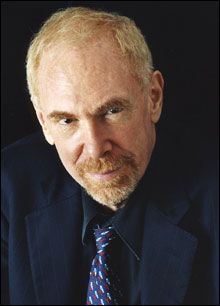
THE RUB: Rosenbaum wants to be a player as well as a war correspondent. |
“For the spirit searcheth all things, yea, the bottom of God’s secrets.” That quotation from the 1557 Geneva Bible’s First Corinthians is the unlikely foundation of Ron Rosenbaum’s The Shakespeare Wars. His life having been transformed by seeing the legendary Peter Brook production of A Midsummer Night’s Dream at Stratford in 1970, the Explaining Hitler author and New York Observer columnist begins by musing on Bottom’s “rare vision.” “I will get Peter Quince to write a ballet of this dream,” Bottom says. “It shall be called ‘Bottom’s Dream,’ because it hath no bottom . . . ” Rosenbaum asks, “Can one get to the bottom of Bottom’s Dream — or to the bottom of its bottomlessness?” And he cites a footnote by Oxford single-volume Dream editor Peter Holland to the effect that Bottom’s garbling of First Corinthians (“The eye of man hath not heard, the ear of man hath not seen”) is Shakespeare’s hint that Bottom isn’t only a weaver’s spool and an arse/ass, he’s “the bottom of God’s secrets.” That’s just the beginning of a 600-page journey in which Rosenbaum, who describes himself as “a kind of guide — leading the reader, like Virgil in Dante, down into the scholarly inferno,” stalks directors, actors, and textual critics along the Stygian shores in an effort to get to the bottom of Shakespeare, if not God. The Shakespeare Wars bottoms out when the author subverts the investigation with interminable soundings of his own depths. But it’s full fathom five down to the Bardic floor. And Rosenbaum has assembled a team of deep divers. There’s Arden 2 Hamlet editor Harold Jenkins railing against the idea that the Folio version of Hamlet is a revision of the Good Quarto (or vice versa) and maintaining there’s a lost archetype that can be approached by “conflating,” or taking the “best” from the different versions. (Rosenbaum adapted the book’s Hamlet chapter for the essay “Shakespeare in Rewrite,” which appeared in the May 13, 2002 New Yorker.) There’s Arden 3 Hamlet co-editor Ann Thompson, who’s putting out the play in two volumes, the Good Quarto in the first and the Bad Quarto (just 2200 lines to the Good Quarto’s 3700) and the Folio in the second, and letting the reader decide what is and isn’t Shakespeare. Rosenbaum finds long-haired Gary Taylor in a Krispy Kreme doughnut shop in a strip mall in Tuscaloosa, Alabama; Taylor, whom he describes as one of the “Raiders of the Lost Archetype,” was responsible for the printing of two versions of King Lear, the 1608 Quarto and the Folio, in the 1986 Oxford Complete Works of Shakespeare. Paul Werstine, co-editor of the Folger Library edition of Shakespeare, undermines both the popular explanations of the Bad Quarto of Hamlet (memorial reconstruction by actors; Shakespeare’s first draft) without offering anything in their place. Bernice Kliman, editor in chief of the Modern Language Association’s new Variorum Hamlet, refuses to reduce the Hamlet controversies to “a single Right Answer, Male Answer Syndrome style.” Eric Sams is the Bard’s “avenging angel,” using Ockham’s razor to shave (and often nick) those academics who favor memorial reconstruction or the idea of Shakespeare as a late starter. Both Jenkins and Sams died before the book’s publication; of Sams, Rosenbaum says, “I liked the old curmudgeon.”

There’s more, like the cautionary example of Donald Foster, the Vassar College English professor who with his spectral SHAXICON digitized database identified the 1612 poem “Funeral Elegy” as the work of Shakespeare and became a media sleuthing superstar (he also identified Joe Klein as the author of Primary Colors); it all came crashing down in 2002 when the “Elegy” was shown to be the work of John Ford. Barbara Mowat, co-editor of the Folger Library edition of Shakespeare, provides what Rosenbaum calls “the most gratifying moment in my odyssey among textual scholars” when she tells him, “Oh, you know what you’re talking about.” Sir Peter Hall, founder of the Royal Shakespeare Company, pounds the table in a Greenwich Village restaurant, “rattling the silverware in precise iambic pentameter,” as he insists on the momentary “PAUSE” at the end of each Bardic verse; Barry Edelstein, director of the Classic Stage Company in New York, wins the author’s approval with his refinement of the “PAUSE” as “the moment the actor, as the character, takes to think up the next line.” There’s John Andrews, editor of the original-spelling Everyman editions of Shakespeare, and actor Steve Berkoff, with his one-man show Shakespeare’s Villains, who speaks of a connection between sex and violence “in Shakespeare’s warped mind,” and Stephen Booth of the out-of-print Essay on Shakespeare’s Sonnets, and of course Peter Brook himself.